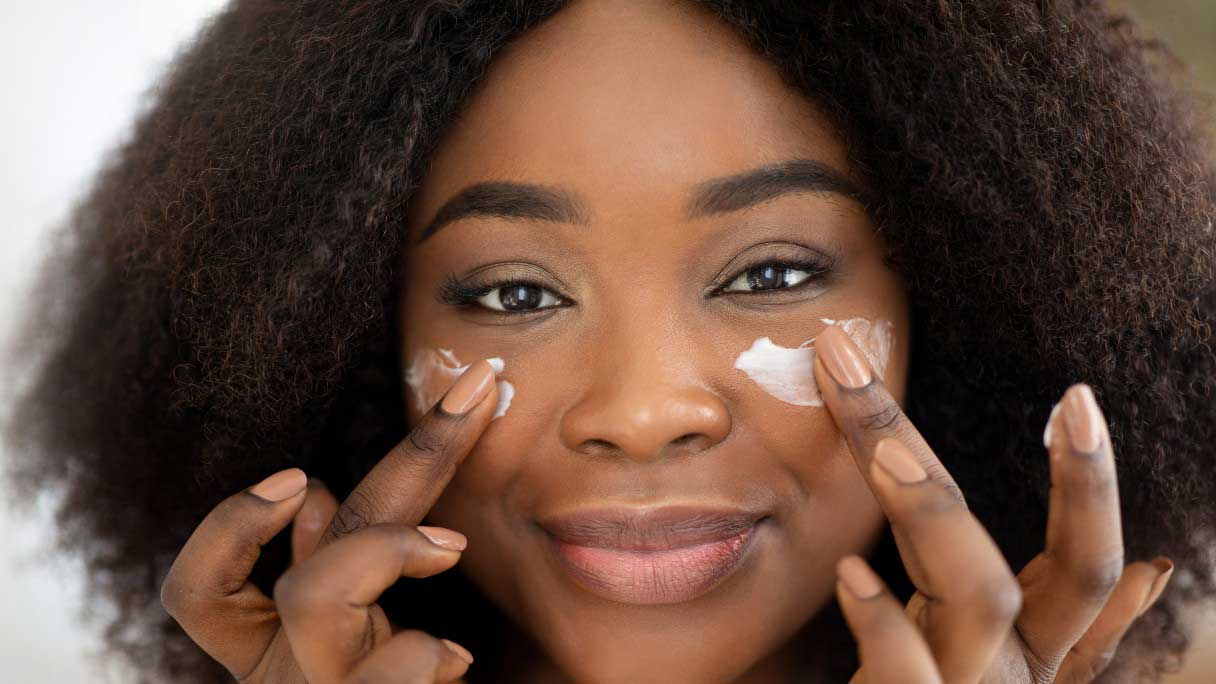Fine lines, wrinkles and sagging skin are all part of the natural aging process, and collagen — or lack of it — is often the culprit. The loss of collagen with age causes our skin to lose its firmness, and nowhere is this more evident than in our face. You can't stop aging, but you do have options that can help rebuild collagen in your face for smoother, younger-looking skin.
Let’s look at these options, including lifestyle changes and products you can use on your own, along with cosmetic treatments that can improve your skin with a little help from a cosmetic professional.
What Is Collagen?
Collagen is a protein that's naturally produced by our bodies and secreted primarily by connective tissue cells. It works with other proteins and substances, like elastin and hyaluronic acid, to help maintain skin elasticity, moisture and firmness.
Collagen decreases as you get older
Your body’s collagen production starts to slow down in early adulthood, gradually slowing by about 1% to 1.5% each year. This reduction can lead to visible signs of aging, like wrinkles and sagging.
While this process can't be stopped, several factors influence how quickly it happens. Hormones, genetics and ethnicity play a role in collagen production, along with environmental influences like sun exposure and pollution. Certain lifestyle choices, such as smoking, can also impact your body's ability to produce collagen.
The good news is that there are several cosmetic treatments that can rebuild or restore collagen.
How to Restore or Increase Your Collagen
There are a number of cosmetic treatments that can reduce the appearance of fine lines and wrinkles with increased collagen production as a side effect.
Here's a breakdown of various collagen restoration options, how they work and their average costs.
1. Chemical peel
Chemical peels use acid solutions to exfoliate dead skin cells, helping to stimulate collagen production. These treatments can be customized with varying strengths, offering results that range from superficial to deep, depending on the desired outcome. You'll be able to see the results of your chemical peel once your skin heals. Based on the strength of the chemical peel, healing time can range from one to 21 days.
The national average cost* of a mild chemical peel is $249. The average cost* increases to $656 for a medium chemical peel and $2,708 for a deep chemical peel.1
2. Collagen induction therapy
Collagen induction therapy is more commonly known as microneedling. This minimally invasive procedure is performed using a pen-like device that creates pinpoint-sized wounds in the skin. This encourages your body to produce more collagen to repair the injured skin. The holes made in the skin are so small that they shouldn't be noticeable after the procedure. A local anesthetic is applied beforehand to minimize discomfort.
The average cost* of microneedling is $954 but can range from $737 to $1,880, depending on the treatment area, the number of sessions required, your skin condition and the location of your clinic.1
3. Collagen treatments
Collagen treatment, or collagen replacement therapy, is a non-surgical procedure that involves injecting the skin with collagen. There are a few types of FDA-approved collagen treatments, including:
- Cosmoderm® or Cosmoplast®. Derived from human tissue
- Zyderm® and Zyplast®. Forms of bovine (cow) collagen that are highly purified and very similar to human collagen
- Bellafill®. A hybrid filler that contains bovine collagen and a synthetic substance called polymethyl methacrylate (PMMA)
Bovine collagen requires a skin test before use to make sure you’re not allergic to it. To do this, your cosmetic surgeon injects a small amount of the collagen into your forearm.
Collagen treatment typically takes 30 to 60 minutes, and there’s no downtime required. Results are instant but not permanent because the injected collagen will wear away over time, just as your natural collagen does. You can maintain your results with touch-up treatments every three to six months. The collagen/synthetic hybrid Bellafill, however, is longer-lasting and can last up to five years.
Bovine and human-derived collagen treatments cost between $500 and $600 per syringe.2 The average cost* of Bellafill is $1,103 but ranges between $854 and $2,017 per syringe.1
4. Injectable filler
Dermal and facial fillers injected into specific areas of the skin, like facial wrinkles, stretch collagen-producing cells while adding volume to the skin for a smoother, more youthful appearance.
There are different types of fillers, such as hyaluronic acid (Juvéderm® and Restylane®), calcium hydroxylapatite (Radiesse®) and poly-L-lactic acid (Sculptra®). Results can last from six to 24 months, depending on the type of filler and area injected.
The cost also varies significantly among the different types of fillers, from $350 to $4,389. Fat transfer fillers, which are fillers that use a person's own fat, typically cost more, at an average of $5,440.3
5. Light therapy
Light therapy, also called LED light therapy, is a facial rejuvenation treatment that uses light to stimulate collagen production.
Red light and blue light are the most commonly used. Red light penetrates the outer layer of the skin to trigger collagen growth and create smoother skin to reduce signs of aging. Blue light penetrates deeper and reduces the amount of oil produced by the oil glands to help treat acne.
Light therapy may involve lying under a light-emitting device or wearing a lighted mask, or the provider may use a wand to deliver light to the skin. Sessions typically take around 30 minutes and don’t require any downtime. Multiple treatments are usually needed to achieve and maintain your results.
The average cost* of red light therapy is $55 but ranges between $43 and $106. The average cost* of blue light therapy is the same, but the range varies a bit between $43 and $108. Costs depend on the size of the area being treated and where the provider is located.1
6. Facial lasers
Facial lasers are a type of facial rejuvenation treatment that uses skin resurfacing lasers to create controlled damage to the skin, which encourages the growth of new collagen-producing cells.
Laser skin resurfacing treatments fall into two categories:
- Non-ablative. Doesn't injure the surface of the skin, is less expensive and only requires a topical numbing agent, if desired
- Ablative and fractionally ablative treatments. Penetrate both the superficial and deep layers of the skin and usually require the use of local anesthetic injections, oral pain medication or IV sedation to keep you comfortable
Ablative and non-ablative treatments affect your skin differently, with the ablative laser procedure usually requiring more downtime. A cosmetic professional can help you choose the best option for you based on your skin and preferences.
The average cost* of non-ablative treatment is $1,815. Ablative treatment is more expensive, with an average cost* of $2,809.3
7. Platelet-rich plasma (PRP) therapy
PRP therapy is also known as the vampire facelift. While this collagen treatment is a bit more involved than your average day spa service, it's not invasive, nor does it involve an actual facelift — or vampires.
This three-step, antiaging cosmetic treatment uses your blood to naturally stimulate new collagen and tissue growth:
- A small amount of blood (2 to 4 tablespoons) is drawn from a vein in your arm.
- The blood is placed in a machine that separates the platelet-rich plasma from the other components in your blood.
- The plasma can be topically applied after a microneedling procedure or injected into your face.
The average cost* of a PRP treatment is $780 but can range from $412 to $4,013, depending on the amount used, the number of treatments and the provider's location.3
Natural Ways to Rebuild Collagen in the Face
You can help boost your body's collagen production naturally through foods and supplements, as well as certain lifestyle changes. These same dietary and lifestyle factors that help you increase your body's collagen also offer health benefits that can translate to looking and feeling your best.
While supplements may help maintain collagen levels in the skin, taking supplements will not result in the same outcome as one of the medical treatments listed above.
1. Dietary changes
- Eat collagen-boosting foods. High-protein foods, such as fish, poultry and legumes, may stimulate collagen production because they contain the amino acids that make collagen.
- Reduce your sugar intake. Consuming excess sugar increases advanced glycation end products (AGEs), which damage collagen and elastin.
- Drink enough water. Water is found in every cell in your body, and drinking more of it has been shown to improve skin health and function.
- Up your vitamin C intake. Vitamin C plays a role in making collagen and also boosts the immune system, which is a win-win. Citrus fruits, leafy greens and tomatoes are examples of foods rich in vitamin C.
- Eat antioxidants. Antioxidants fight inflammation and have been shown to reduce wrinkle severity. Fun fact: Vitamin C is an antioxidant! Along with the foods listed above, you can add more fruits, veggies and nuts to your diet to boost your daily dose of antioxidants.
- Take ginseng. Ginseng has numerous benefits for the skin, ranging from increasing collagen formation to protecting against sun damage. It’s available in different forms, including teas and capsules.
- Consume bone broth. Bone broth is a collagen-rich option that can be purchased in stores or made at home. However, it's important to note that the amino acid content in bone broth can vary significantly depending on the brand and type of animal bones used.
- Try collagen supplements. Taking a collagen supplement may improve your skin’s firmness and moisture, particularly those high in peptides that contain the amino acids prolyl-hydroxyproline and hydroxyprolyl-glycine.
- Add oral hyaluronic acid. Remember earlier we mentioned that hyaluronic acid in your body works with collagen? Turns out that topping up hyaluronic acid with a supplement can help increase skin’s moisture and thickness and improve discoloration.
2. Lifestyle changes
Making these changes can help improve your body’s natural collagen production:
- Don’t smoke. You can protect your skin’s natural collagen production by not smoking and avoiding secondhand smoke.
- Enjoy a facial massage. A facial massage increases blood flow, promotes cell renewal and stimulates collagen production. And yes, it feels incredible, too.
- Get enough sleep. Like stress, sleep deprivation increases cortisol levels, which can impede your body’s collagen production. Aim for seven to nine hours of sleep each day.
3. The right skin care
Some skin care products are better than others for boosting or preserving your body’s natural collagen. Here are some that are worth adding to your antiaging regime:
- Collagen-boosting skin products. Skin care products containing collagen have been shown to slow or delay skin aging, but don’t expect dramatic results as not all the collagen actually penetrates the skin. Instead, consider a moisturizer with sunscreen to protect against collagen loss.
- Retinoid. Skin care products that contain retinoid (or retinol) improve skin tone and texture by speeding up skin cell turnover and increasing collagen. Retinoids aren’t for everyone and can cause irritation, so be sure to consult a dermatologist first.
- Sunscreen. The sun’s rays are a leading cause of premature aging (and skin cancer) so a broad-spectrum sunscreen with at least SPF30 is a must. Apply it to skin not covered by clothes every time you’re going outdoors.
Tips to Prevent Collagen Loss
Along with the many ways you can restore collagen loss in the face naturally and through dermatology treatments, there are also things you can do to prevent collagen loss. Here are some simple tips to help prevent collagen loss:
- Avoid alcohol. Alcohol can dehydrate and damage the skin, making it appear older.
- Avoid direct sun exposure. Getting just 10 to 20 minutes of direct midday sun three to four times a week is all you need for vitamin D. Otherwise, avoid direct sunlight to prevent collagen loss.
- Eat a healthy diet. Reduce consumption of fats and sugar and add more fruits, vegetables, grains and protein to your diet to improve your skin and overall health.
- Manage stress. It may be easier said than done sometimes, but try to manage your stress. Stress increases cortisol, which can decrease collagen production.
- See a cosmetic professional. Get professional protection against collagen loss from a dermatologist or other cosmetic professional. A pro can guide you on the best types of treatments to prevent collagen loss based on your skin’s unique needs.
If you're considering collagen treatments to help rebuild collagen in your face, a good place to start is consulting with a dermatologist or cosmetic skin care specialist. They can answer your questions and work with you to determine the best collagen-rebuilding treatment for your cosmetic goals.
Financing Collagen Treatments With the CareCredit Credit Card
When getting collagen treatments or another cosmetic procedure, the CareCredit credit card can help you pay for costs not covered by insurance.** Use our Acceptance Locator to find a doctor or cosmetic specialist near you that accepts CareCredit. Continue your wellness journey by downloading the CareCredit Mobile App to manage your CareCredit account, find a provider on the go and easily access the Well U blog for more great articles, podcasts and videos.
In addition to cosmetic procedures, you can also use your CareCredit credit card for dentistry, pet care, vision, hearing, health systems, dermatology, pharmacy purchases, spa treatments and so much more within the CareCredit network. How will you invest in your health and wellness next?
Expert Reviewer
Brian Reagan, M.D., F.A.C.S.Dr. Brian Reagan, M.D., F.A.C.S.
Dr. Brian Reagan, a renowned specialist within his field, has spent many years in training and practice. His experience includes writing published articles and completing a National Institute of Health research grant on the science of wound healing and trauma. Dr. Reagan specializes in plastic surgery of the face, breast and body, and is one of the few plastic surgeons in the country skilled in the novel drainless tummy tuck technique.
Author Bio
Adrienne Santos-Longhurst is a writer who has been covering health and lifestyle for almost two decades. Her work has appeared in Healthline, Insider, Medical News Today and more.







